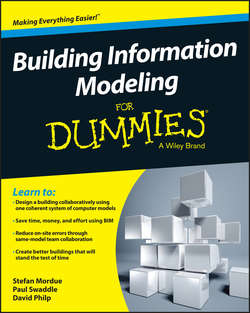Читать книгу Building Information Modeling For Dummies - Swaddle Paul - Страница 15
На сайте Литреса книга снята с продажи.
Part I
Getting Started with Building Information Modeling
Chapter 2
Explaining the Building Part of BIM: It’s Not Just Buildings
Developing Building Processes and BIM
ОглавлениеBIM isn’t just technology and it’s definitely not just software. BIM is a best-practice process and therefore can impact project management and procurement just like some methodology, such as PRINCE2 or Agile, may completely restructure the delivery of a computing project.
Detailed discussions about BIM processes and your ability to explain them can easily become the focus. Bring the attention back to the outputs and outcomes of the project and the benefits of using BIM for asset information. The following sections begin to look at how you can develop BIM processes for the whole timeline of a built environment project. BIM applies right across the lifecycle and can improve design, construction, and operation.
Investigating design
BIM has the potential to make the design process easier and more efficient. Basic benefits of digital modeling include the ability to check if one designer’s work clashes with another, being able to try lots of iterative designs out and fully understanding their impact, and better energy modeling and analysis.
✔ Clash detection: Projects that use BIM need the whole project team to work together, and each discipline will be developing a model in isolation. This can lead to coordination issues like overlapping systems or designs that can’t be built because of other components getting in the way. When the models are brought together, it’s important that problems are resolved and communicated through clash detection tools.
✔ Multiple design options: BIM lets you build digitally before you ever have to try things on-site. This opens up lots of possibilities, so you can test your ideas and work through many structural, engineering, and design concepts. The benefit of BIM is being able to interrogate these concepts in terms of their cost or complexity by using intelligent BIM objects. Then the entire project team can review the design at regular stages.
✔ Energy analysis: The construction industry is gradually becoming more sustainable, aiming to reduce energy use and waste on projects. BIM during design phases allows you to understand the impact of design decisions on energy use, overheating, and air circulation through energy analysis tools.
Using BIM in construction
BIM has many benefits during the construction phase of built projects. BIM can be used to schedule and plan out the construction process, including the movement of vehicles and plant machinery. The design decisions made in the model and increased precision of measurement should result in less wastage and higher accuracy during installation, along with the ability to explain difficult construction details.
Using the model as a communication method improves project teams’ ability to collaborate and coordinate the work being done on-site. The model can also be used to calculate and manage the cost and time constraints of the project. In the long term, BIM will move toward automating the process of code approvals and building regulations too.
Operating the built environment
BIM can reduce costs during the operation phase of buildings, because the model forms an as-built record of all the systems constructed and installed. If the model is kept up to date, then BIM becomes an ongoing process to track maintenance, issues, and changes through the life of an asset. You can alert operational teams when systems are about to fail, pass their warranty date, or when they require maintenance or replacement according to a pre-written schedule.
As built assets become more automated and require more advanced building management systems, the BIM process will become fully integrated with these systems. You’ll be able to optimize heating, ventilation, and lighting systems based on the real-time use of spaces.
Building a solid foundation
BIM can dramatically change many industries, and it needs a combination of people, processes, and platforms with data at the centre. Instead of the traditional industry resulting in one built asset, BIM will provide two, a physical and a digital one. Make sure that both are well designed and constructed securely using best practices, and that they’re easy to understand and maintain during their use.
